Know your wood #2-Beech
Beech trees grow abundantly throughout the temperate zones of Europe, Asia and North America. The wood is of very even denseness throughout the grain because of its relatively small pores evenly distributed through both the early and late growth of each growth cycle (annual ring). My first mallet was made from beech and most mallets for three hundred years would have come from the beech tree. Though that is the case, and beech is a hard wood, I find beech just a little too soft for making mallets of enduring quality from and so, in my view, mallets of beech have a limited lifespan. Probably fifteen years for me.
Entering the surface fibres of beech relies on a sharp cutting edge and the wood’s even denseness means that penetration requires greater pressure than say oak or cherry. Though common enough, beech is not so commonly stocked as other hardwoods in the US. In Europe it’s much more common and I find it available in many small lumber companies.
Beech leaves against the smooth silver grey of the beech tree trunk
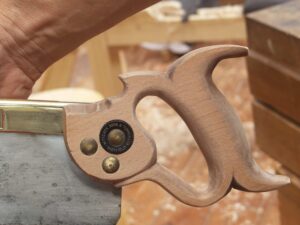
Beech handled saw
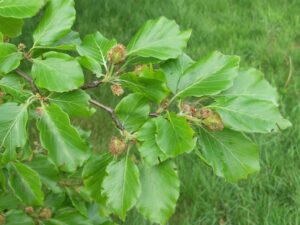
I first laid my hands on beech when I turned my first piece on the lathe when I was 13. It was a hefty rolling pin.
Early-growth beechnuts
Beech trees grow to huge sizes and 4′ diameters are not uncommon.
A beech marking gauge
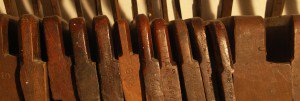
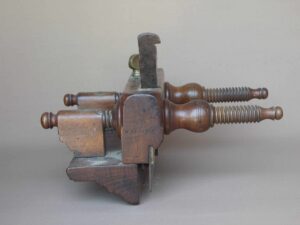
Beech is a stable almost textureless wood that distorts minimally, even with weather changes, though no wood is exempt from some measure of distortion. It’s an easy wood to work whether by machine or hand tool method, though often prone to tear for no apparent reason. I like to work beech, it responds well in general to hand planes and scrapers and also sands well.
A beech, screw-stem plough plane-one I still use
Fully grown beech tree
These are my thoughts from working with beech and seeing the work wrought in it by craftsmen of old. Here at the woodworking school we use a variety of domestic European hardwoods using hand tools. I don’t think beech to be an attractive wood: It has no swirling grain and very little variation. Stain makes little difference to its colourless character, but its silent and hidden strengths have stood the test of time for craftsmen for millennia.



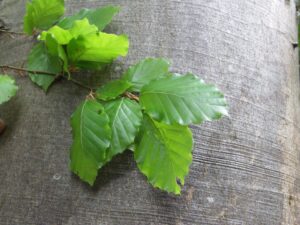
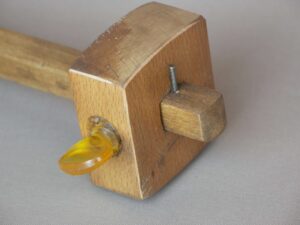
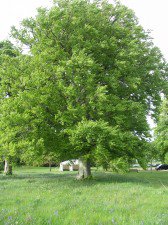

Is it just me or is it pretty hard to make mortises on beech? having a bit of a hard time (newb alert btw)
It should be like other domestic medium density hardwoods. Not to hard. But persevere and you will develop a rhythm with practice.
You are right practice, practice, practice, I realized my fold-up workbench was not up to the task .. too much bounce or something, so I found a solid bench in the park and sat on the workpiece getting much better hits, can’t quite remove material you do on oak but definitely improving.
Beech feels a bit different to plane as well, I never did manage to get a nice long shaving even on thin pieces even though the grain looks super even, but I was encouraged by one of your videos where you say that it isn’t really neccesary and it looks pretty darn good after a little scraping ,
What about (steamed) beech for workbench tops? Would it be worth it over pine, spruce or fir?
I’m pretty sure that hardwoods give you nothing more really over the softwoods except a higher cost. Certainly functionality wise they don’t. I’m afraid no one will convince me differently after 50 years experience with both. Mostly I think people take a little more pride about making something in any other wood other than pine or some other softwood. I don’t. I like other challenges in my life now whereas when I was a young craftsman I might have fallen into that trap. I just love all woods and whereas some woods would be way too soft, there are not too many and certainly not spruce or pine. They are just perfect for benches. That said, if you want beech or oak or some Malaysian wood, just go for it and enjoy.
Thank you for the (quick) reply.
I had been reading some books on benches, and watching some videos on the same. Some people just seem to fall in love with certain types of wood (Wood by Wright comes to mind), which is fine, and some books also list a number of types of wood, their density and such. With your advice, which I value a lot, I do come back to my initial plan of building a bench out of spruce / Picea abies, as it is pretty cheap and easy to get in the Netherlands. And if it pleases me, or just to get experience with other wood types along the way, at some point in time I may build one out of another (potentially harder) wood.
Hi Paul,
I find very difficult to plane beech end grain, or just to pare with a chisel (sharp).
Do you think it could be better to make a shooting board or to use a low angle plane (I had a vintage coffin with the iron lower than 40°)?
Or it is just that this wood is somethimes really tough?
Thanks,
Valerio.
I’m not sure why you’re having difficulty because beech is not particularly hard usually. Let me think on it.
I’m currently making a Beech sword for my Son, based on the Sutton Hoo sword. I got a short plank from a great guy local to me in the Chiltern Hills, who harvests his own wood in a traditional way. I wanted to make something from locally grown timber and Beech has always been used in the Chilterns for furniture making and Bodgers were found in many woods around the area up until the 60’s.
I’m finding the wood a little quirky to work with using my spokeshave, with sudden and unexpected changes in the grain, but if you don’t get carried away, it works well.
I love this site, so much information and so well explained. I will be sharpening my smoothing plane this week and the guide here on how to set it up will prove invaluable! Cheers!